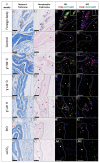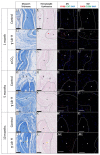The cell-assembled extracellular matrix: A focus on the storage stability and terminal sterilization of this human "bio" material
- PMID: 37149079
- PMCID: PMC7614989
- DOI: 10.1016/j.actbio.2023.05.002
The cell-assembled extracellular matrix: A focus on the storage stability and terminal sterilization of this human "bio" material
Abstract
The Cell-Assembled extracellular Matrix (CAM) is an attractive biomaterial because it provided the backbone of vascular grafts that were successfully implanted in patients, and because it can now be assembled in "human textiles". For future clinical development, it is important to consider key manufacturing questions. In this study, the impact of various storage conditions and sterilization methods were evaluated. After 1 year of dry frozen storage, no change in mechanical nor physicochemical properties were detected. However, storage at 4 °C and room temperature resulted in some mechanical changes, especially for dry CAM, but physicochemical changes were minor. Sterilization modified CAM mechanical and physicochemical properties marginally except for hydrated gamma treatment. All sterilized CAM supported cell proliferation. CAM ribbons were implanted subcutaneously in immunodeficient rats to assess the impact of sterilization on the innate immune response. Sterilization accelerated strength loss but no significant difference could be shown at 10 months. Very mild and transient inflammatory responses were observed. Supercritical CO2 sterilization had the least effect. In conclusion, the CAM is a promising biomaterial since it is unaffected by long-term storage in conditions available in hospitals (hydrated at 4 °C), and can be sterilized terminally (scCO2) without compromising in vitro nor in vivo performance. STATEMENT OF SIGNIFICANCE: In the field of tissue engineering, the use of extracellular matrix (ECM) proteins as a scaffolding biomaterial has become very popular. Recently, many investigators have focused on ECM produced by cells in vitro to produce unprocessed biological scaffolds. As this new kind of "biomaterial" becomes more and more relevant, it is critical to consider key manufacturing questions to facilitate future transition to the clinic. This article presents an extensive evaluation of long-term storage stability and terminal sterilization effects on an extracellular matrix assembled by cells in vitro. We believe that this article will be of great interest to help tissue engineers involved in so-called scaffold-free approaches to better prepare the translation from benchtop to bedside.
Keywords: Cell-assembled extracellular matrix; In vivo remodeling; Mechanical properties; Physicochemical properties; Sterilization; Storage stability.
Copyright © 2023. Published by Elsevier Ltd.
Conflict of interest statement
Declaration of Competing Interest The authors declare that they have no known competing financial interests or personal relationships that could have appeared to influence the work reported in this paper.
Figures






References
-
- U.S. National Library of Medicine. ClinicalTrialsgov-Tissue engineering. [accessed April 9, 2022]. (n.d.). https://www.clinicaltrials.gov/ct2/results?cond=&term=tissue+engineering...
-
- Alliance for Regenerative Medicine. Alliance for regenerative medicine, Available products. 2023. (n.d.). https://alliancerm.org/available-products/
-
- Wystrychowski W, Garrido SA, Marini A, Dusserre N, Radochonski S, Za-galski K, Antonelli J, Canalis M, Sammartino A, Darocha Z, Baczyn’ ski R, et al. Long-term results of autologous scaffold-free tissue-engineered vascular graft for hemodialysis access. J Vasc Access. 2022:112972982210959. doi: 10.1177/11297298221095994. - DOI - PubMed
-
- Magnan L, Labrunie G, Fénelon M, Dusserre N, Foulc M-P, Lafourcade M, Svahn I, Gontier E, Vélez JH, McAllister VTN, L’Heureux N. Human textiles: A cell-synthesized yarn as a truly “bio” material for tissue engineering applications. Acta Biomater. 2020;105:111–120. doi: 10.1016/j.actbio.2020.01.037. - DOI - PubMed
Publication types
MeSH terms
Substances
Grants and funding
LinkOut - more resources
Full Text Sources
Research Materials

